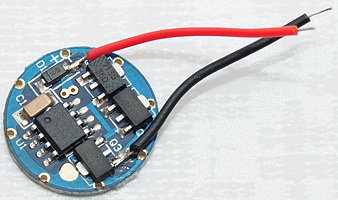Simple battery selection guide
This is a very simple guide in how to select the best battery for different types of flash lights, using the charts shown above. In the guide it is assumend that the leds are driven at full power.
Index
Summary for all tested batteries
Common curves for all tested batteries
Common curves for all tested batteries, the low part
Common curves for all tested batteries, the medium part
Common curves for all tested batteries, the high part
Comparator
Simple battery selection guide
Individual tests
How is the test done and how to read the charts
How is a protected LiIon battery constructed
More about button top and flat top batteries
Battery size and shape
Remember always to check if the light supports the length of the battery (See length chart in the summary) and shape of the positive nipple (see More about button top and flat top batteries).
For some 2xCR123 lights it might be necessary to use 16xx0 or 17xx0 batteries.
It is strongly recommended to use protected batteries in most light both for safety and for long battery life (Any battery discharged to much take serious damage).
Lights with 2x18650 batteries in series

These lights will usual use a buck converter to adjust the voltage, this means that a XR-E, XP-E is 0.5A, XP-G is 0.7A, and a XM-L is 1.5A. With two batteries in series the light can use all the capacity in the battery, while staying at full brightness. I.e. the "Discharge, capacity" chart is the one used here.
For 0.5A current, look for the batteries with the longest green bar, they will give most runtime.
For 0.7A current, look for the batteries with the longest green and blue bars, they will give most runtime.
For 1.5A current, look for the batteries with the longest blue and cyan bars, they will give most runtime.
Lights with 1x18650 batteries or 2xCR123 batteries

These lights will usual use a buck converter, but typically have trouble maintaining full brightness when the 18650 battery voltage is low. For current XR-E, XP-E is 1A, XP-G is 1.5A, and a XM-L led will need 3A.
To find the battery that maintains the highest brightness for the longest time use the chart "Discharge, capacity down to 3.6 volt"
For 1A current, look for the batteries with the longest blue bar, they will give most runtime.
For 1.5A current, look for the batteries with the longest blue and cyan bars, they will give most runtime.
For 3A current, look for the batteries with the longest yellow bar, they will give most runtime.
Note: These lights will sometimes be fairly safe with unprotected batteries, especially with cell that can be discharged down to 2.5 volt.
Lights with 1x18650 batteries and linear driver (7135 chip)

In this type of light the current in the led is the same as the current drawn from the battery. These light need as much voltage as possible to maintain regulation. For current XR-E, XP-E is 1A, XP-G is 1.3A, and a XM-L led will need 3A. if it is possible to count the number of 7135 chips in the driver, it is very easy to calculate the current. Each chip is 1/3 ampere, i.e. 3 chips is 1 ampere.
To find the battery thats maintain the highest brightness for the longest time use the chart "Discharge, capacity down to 3.6 volt"
For 1A current, look for the batteries with the longest blue bar, they will give most runtime.
For 1.3A current, look for the batteries with the longest blue and cyan bars, they will give most runtime.
For 3A current, look for the batteries with the longest yellow bar, they will give most runtime.
Note: These lights will often be fairly safe with unprotected batteries, especially with cell that can be discharged down to 2.5 volt.
Other lights
For other lights a tailcap current measurement can help with establishing the current draw.
Or use power calculations to estimate current: For each led add the watt together: XR-E and XP-E is 3.5W, XP-G is 5.4 W and XM-L is 10 W, divide sum by number of batteries and by 3.7, the result is the current.
An example for A 3 XM-L light with 4 batteries: 10+10+10->30 watt, 30/4/3.7 -> 2 ampere from each battery (It does not matter if they are series or parallel).
Use the "Discharge, capacity" for lights with two or more 18650 cells in series or the "Discharge, capacity down to 3.6 volt" for lights that only works on a single 18650 battery or uses a couple of 18650 in parallel.
When mostly using low modes
For low modes it is the 0.2A red and 0.5A green bar that is most interesting. To see which one, use a tailcap current measurement. For currents below 0.2A it is fine to use the 0.2A bar, lower current draw will not change the rating of the batteries significantly.


